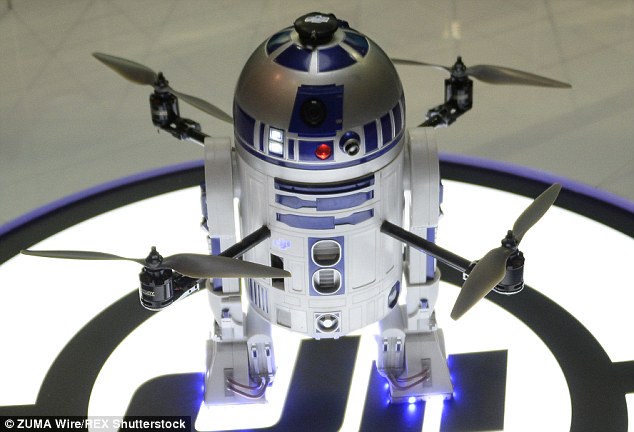Our Drone Will Go Where the Empire, er, TCEQ Won’t
 In yet another shift away from the state's monopoly on air quality information, breathers in North Texas won't have to rely on the Austin-designed system of local air monitoring much longer.
In yet another shift away from the state's monopoly on air quality information, breathers in North Texas won't have to rely on the Austin-designed system of local air monitoring much longer.
On Sunday, Downwinders at Risk won its category in the Earth Tank competition at Earth Day Texas and brought home $3000 to buy a drone the group will modify to perform its own air DFW sampling and monitoring operations.
Working with the TCU engineering department, Downwinders will use the money to purchase a heavy-duty consumer drone and outfit it with small air pollution sensors and sampling equipment that work in concert with smart phones and laptops. The result will be an instrument able to give citizens and scientists real time information about air pollution.
As far as we know, we'll be the first group in the state to have this kind of capability.
Our presentation on Sunday made the case that the current DFW air monitoring network run by the Texas Commission on Environmental Quality gives an incomplete picture of air pollution threats in DFW. Both the limited number of air monitors and their immobility were cited as faults that could be depriving residents of a fuller, more accurate picture of DFW's chronic air pollution problems. Our answer was an air sampling drone that could go practically anywhere at anytime and sample for many different pollutants depending on what's being monitored.
One of the examples we used was Wise County, which is the most recent addition to the DFW 'non-attainment area" for smog. Despite it now being a part of the regulated smog zone, and despite the fact repeated computer air modeling by the state shows the highest smog levels in the region could be found there, Wise County has no smog monitors. Not a one.
Austin knows if it puts a new monitor is Wise County, DFW's annual smog average might go up even higher than it is now, and so the TCEQ has treated the County like it's not there.
Downwinders' drone will be able to show-up in Wise County on "ozone action days" and actually take real time measurements of smog for evidence demonstrating the need for an official monitor. TCEQ already hates this idea.
We'll also be able to do things like take methane readings over the gas patch, montior the plumes at accident sites (think the Magnablend catastrophe in Waxahachie a few years ago), and carry out experiments and research projects for area scientists – all the things TCEQ should be doing, but isn't.
This new tool allows us to enter into colaborations with other groups, local governments, and university programs. It's a teaching device we can take to schools. It can back-up citizen complaints. The uses are many.
But as we told the panel of judges on Sunday, our real "killer app" is not the drone itself, but the organization of people we put in place to operate it and decide how to use it.
Dr. Michael Slattery of the TCU Institute of Environmental Studies will head a group of researchers, technicians, and citizens who will assess projects, train drone pilots, and help administer "The North Texas Clean Air Force." Downwinders at Risk board member and Mansfield fracking activist Tamera Bounds has already signed-up. "I can't wait to learn how to fly that thing."
With the creation of this group, we'll be establishing a parrallel air quality monitoring program that once again opens up a previoulsy closed black box in Austin to citizen use. Just last November, we unveiled our DFW Ozone Study that, for the first time ever, took the state's own computer air model for DFW, cloned it, and had it do things the state did not want done – like tell us how much less smog would be breathed in DFW if you put modern controls on the largest industrial polluters.
In taking on these responsibilities which have tradtionally fallen to the state, our goal is not only to provide valuable new tools to citizens, but build new structures of decision-making about air quality that puts citizens in charge. For us, it's as important to change the way we make decisions as it is to add to the scientific literature, or bring smog levels down. It's right there in our mission statement,
Our goal is to build a strong grassroots constituency and create new strategies for clean air in North Texas.
We do this by informing, connecting and mobilizing citizens to become active participants in the decision-making that affects the air we breathe.
In doing so, we improve both the quality of our air and the quality of our democracy.”
We still have a lot of research to do, a lot of mistakes to make, a lot of experience to absorb, but creation and operation of a North Texas Clean AIr Force is one more step to building the kind of citizens' self-defense system necessary when your state government abdicates its job of public health protector.
Now, because the state's monopoly on data is crumbling with each new advancement in micro-processing, we're willing and able to step into this vacuum of leadership. Our goal is not only taking over the jobs Austin isn't doing, but creating a more citizen-friendly way of doing those jobs.
Move over TCEQ, the North Texas Clean Air Force is about to take off.
